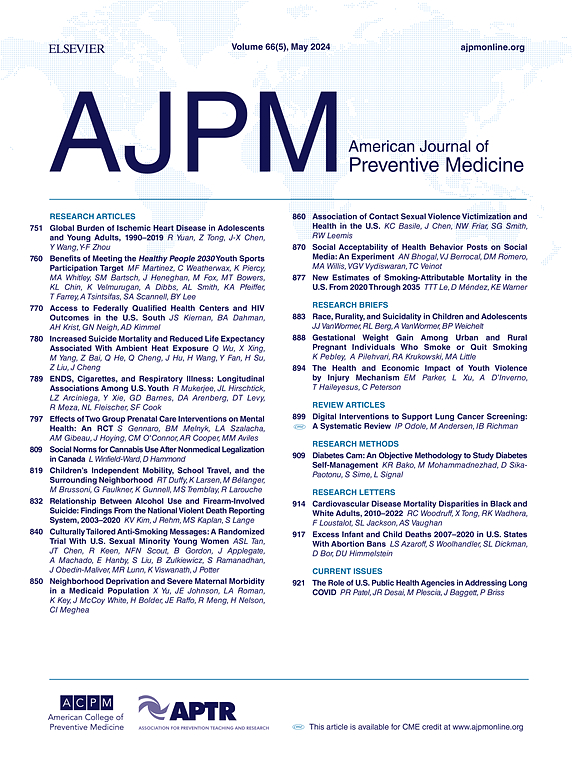新冠肺炎住院期间未参保人群的糖尿病发生率
IF 4.3
2区 医学
Q1 MEDICINE, GENERAL & INTERNAL
引用次数: 0
摘要
未确诊的糖尿病与缺乏保险有关,这减少了获得预防保健的机会。在2019冠状病毒病大流行期间,以前不为卫生系统所知的无保险患者住院治疗。方法:对2020年6月至2021年12月在安全网卫生系统中因COVID-19住院的糖尿病患者的电子健康记录(EHR)数据进行横断面分析,研究付款人状况与糖尿病事件诊断之间的关系。糖尿病的偶发诊断是通过排除基于过去5年的诊断代码、药物和血红蛋白A1c的先前已知糖尿病诊断来定义的。回归分析评估了支付者状况与糖尿病偶发诊断之间的关系。数据于2023年进行分析。结果:在872例因COVID-19住院的糖尿病患者中,24.0%未参保,34.6%接受县资助慈善保险(CFCC), 17.1%接受医疗补助,24.3%接受医疗保险。总样本中糖尿病的发生率为20.3%;糖尿病的意外诊断在未参保人群中(30.1%)比CFCC患者(18.2%)和Medicare患者(11.3%)更为常见。在调整了年龄、性别、种族/民族和BMI等因素后,未参保患者比参保患者的糖尿病发生率更高(aOR 2.64, 95% CI [1.41-4.92], p=0.002)。CFCC和Medicare患者的糖尿病发生率相似。结论:未参保患者在COVID-19住院期间可能未被发现的糖尿病发生率较高。这些发现反映了未参保人群获得预防保健的机会减少,以及错过了筛查糖尿病的机会。本文章由计算机程序翻译,如有差异,请以英文原文为准。
Incident Diabetes Diagnosis Among the Uninsured During COVID-19 Hospitalization
Introduction
Undiagnosed diabetes is associated with lack of insurance, which decreases access to preventive care. During the COVID-19 pandemic, uninsured patients previously unknown to health systems were hospitalized.
Methods
This is a cross-sectional analysis of electronic health record data from patients with diabetes hospitalized with COVID-19 in a safety-net health system from June 2020 to December 2021, examining the association between payor status and incident diagnosis of diabetes. Incident diagnosis of diabetes was defined by excluding a prior known diagnosis of diabetes based on diagnosis codes, medications, and HgbA1c from the past 5 years. Regression analysis evaluated the association between payor status and incident diagnosis of diabetes. Data were analyzed in 2023.
Results
Among 872 patients with diabetes hospitalized with COVID-19, 24.0% were uninsured, 34.6% received county-funded charity coverage, 17.1% received Medicaid, and 24.3% received Medicare. The rate of incident diagnosis of diabetes in the total sample was 20.3%; incident diagnosis of diabetes was more common among the uninsured (30.1%) than among county-funded charity coverage (18.2%) and Medicare (11.3%) patients. After adjusting for age, gender, race/ethnicity, and BMI, uninsured patients had higher odds of incident diagnosis of diabetes (AOR=2.64; 95% CI=1.41, 4.92; p=0.002) than Medicare patients. Odds of incident diagnosis of diabetes were similar for county-funded charity coverage and Medicare patients.
Conclusions
Uninsured patients had higher odds of incident diagnosis of diabetes during COVID-19 hospitalization that may have gone undetected without hospitalization. These findings reflect decreased access to preventive care and missed opportunities to screen for diabetes among the uninsured.
求助全文
通过发布文献求助,成功后即可免费获取论文全文。
去求助
来源期刊

American Journal of Preventive Medicine
医学-公共卫生、环境卫生与职业卫生
CiteScore
8.60
自引率
1.80%
发文量
395
审稿时长
32 days
期刊介绍:
The American Journal of Preventive Medicine is the official journal of the American College of Preventive Medicine and the Association for Prevention Teaching and Research. It publishes articles in the areas of prevention research, teaching, practice and policy. Original research is published on interventions aimed at the prevention of chronic and acute disease and the promotion of individual and community health.
Of particular emphasis are papers that address the primary and secondary prevention of important clinical, behavioral and public health issues such as injury and violence, infectious disease, women''s health, smoking, sedentary behaviors and physical activity, nutrition, diabetes, obesity, and substance use disorders. Papers also address educational initiatives aimed at improving the ability of health professionals to provide effective clinical prevention and public health services. Papers on health services research pertinent to prevention and public health are also published. The journal also publishes official policy statements from the two co-sponsoring organizations, review articles, media reviews, and editorials. Finally, the journal periodically publishes supplements and special theme issues devoted to areas of current interest to the prevention community.
 求助内容:
求助内容: 应助结果提醒方式:
应助结果提醒方式:


